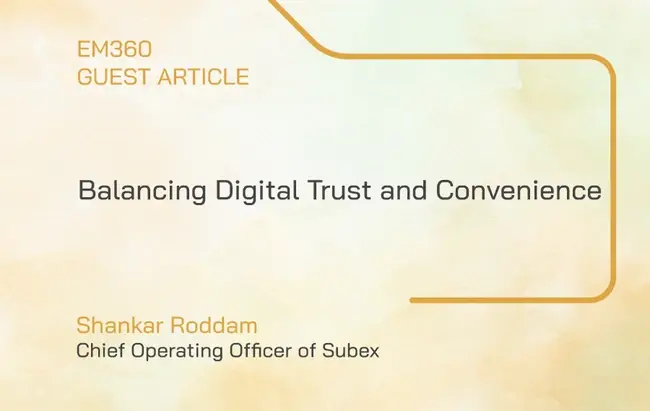
This article was written by Shankar Roddam, Chief Operating Officer at Subex
Improved data-sharing technologies and accelerated digitisation - especially over the past 18 months - have greatly enhanced our lives by powering smart cities and connected solutions, enabling virtual experiences, personalised ads and more. Everything from utilities to banking is just a click or a tap away. However, too much of anything - including too much data sharing and an overdependence on digital technology - is not always a good thing.
Many of us have tried to ride out the pandemic by relying heavily on technology. However, while doing this, we should ask ourselves some important questions: Firstly, are we sharing more personal information than we should? Are new-age apps putting us at an increased risk of becoming targets for cybercrime? And finally, how can businesses find that all-important balance between user friendliness and trust in order to ensure that the user experience is seamless but secure?
As humans, we are always striving to make things easier for ourselves. This is why users all over the world have embraced digitalisation: The growing digital ecosystem has made the services that we need in our daily lives more easily accessible, from shopping online to managing our finances. On the other hand, having information and content instantly available on-demand has also turned us into much more demanding and impatient customers.
As user expectations reach new heights and it becomes harder to stand out from competitors, businesses are investing heavily in delivering a more convenient and more personalised experience. They are watching users closely and collecting even more data to understand what their customers really want.
Not surprisingly, all this online activity is increasingly attracting the attention of cybercriminals, who are constantly looking for new vulnerabilities to exploit. To combat this threat, businesses must sharpen their focus on security to protect the increasing volumes of sensitive customer data that they store and process. As the lines between our online and offline worlds continue to blur, organisations will have to work much harder to balance trust and convenience and deliver an experience that is smooth but secure.
A fine balance
Many users are willing to share personal data for added convenience when using apps or websites. At the same time, more than nine in 10 users are worried that their data might fall into the wrong hands. Personal details such as phone numbers, emails and passwords can be exploited by cybercriminals in myriad ways, including identity theft, account takeovers, hacking and SIM cloning.
And the risks faced by today's digital consumers go far beyond the occasional phishing email. Unfortunately, no one who moves in the digital ecosystem is safe from becoming a victim of cybercrime. Threats have evolved and hackers have developed highly sophisticated attack methods. The dark web is host to dangerous malware and cybercriminals capable of taking down entire governments and economies.
So how do you protect your online customers without compromising usability?
The danger of over-focusing on security is that additional authentication or verification processes can frustrate your users. Ask them to complete too many steps and they may leave before they have even started engaging with your app or website. And a high dropout rate results in increased customer acquisition costs. On the other hand, without adequate security measures, you leave your doors wide open to would-be attackers.
The answer to this dilemma is to strike the right balance by designing applications that deliver strong levels of security with minimal impact to the user flow. The key is to request verification steps only where required. Mechanisms like two-factor authentication can add an extra layer of security. When it comes to app design, less is more, and more can be too much for the impatient user.
In addition, businesses must be open and transparent in how they handle user data. They should communicate clearly to their customers why certain information is collected and how it will be used, and they must avoid requesting data without explicitly mentioning the purpose.
Digital onboarding can improve how the user experience is
When assessing the user journey, it is also critical to consider whether there are better ways to get things done. One of the merits of digital onboarding is that access to related technology and data can significantly improve the user experience by removing extra verification steps. Telecom data, for instance, can be used to confirm the address and location of users, as well as facilitating alternative credit scoring.
Analysing the sequence of events also helps to eliminate any non-essential steps. Credit apps, for example, require a credit score for processing a loan. By assessing the credit score first, additional steps for document verification can be omitted for ineligible applicants.
Applied ethically, data-sharing technologies can simplify complex use cases and can open up new avenues for personalisation. However, to fully exploit their potential and to ensure user data is kept secure, organisations must carefully address the risks associated with data sharing. All organisations that collect and process customer data must do so with a strong trust concept at the core of everything they do. There is a very fine balance between user friendliness and digital security – and achieving it is the holy grail of the digital customer experience.







Comments ( 0 )